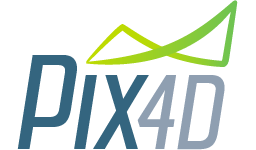Pix4D
Pix4D is a Swiss company which started in 2011 as a spinoff of the École Polytechnique Fédérale de Lausanne (EPFL) Computer Vision Lab in Switzerland and develops a suite of software products that use photogrammetry and computer vision algorithms to transform DSLR, fisheye, RGB, thermal and multispectral images into 3D maps and 3D modeling
| Pix4D | |
|---|---|
 | |
| Information | |
| VR/AR | VR |
| Developer | Pix4D |
| Platform | photogrammetry |
| Operating System | Windows, Linux |
| Type | Software |
| Genre | photogrammetry |
| Input Device | images |
| Language | English |
| Version | 4.5 |
| Release Date | Jul 15, 2019 |
| Website | www.pix4d.com |
Pix4D suite of products include Pix4Dmapper, Pix4Dfields, Pix4Dbim, Pix4Dreact, Pix4Dsurvey, Pix4Dmodel, Pix4Dcapture and Pix4Dengine.
Applications
The major applications are:
- Aerial survey
- Agriculture and Precision agriculture
- Construction
- Cultural heritage
- Education
- Energy
- Mapping
- Surveying
- Mining
- Public safety
- Research
- Humanitarian aid and development aid
- Natural resources and Environment
- Real estate
- Virtual reality (VR)
Languages
Desktop version: English, Spanish, Mandarin (zh-CH, zh-TW), Russian, German, French, Japanese, Italian and Korean. Cloud version: English and Japanese.
Inputs
Images: Images in jpg and tiff format captured by any camera (compact, DSLR, thermal, multispectral, fisheye, 360°, large-frame etc.) Videos: Video up to 4k resolution in avi, mov, wmv, and mp4 format (4k resolution recommended)
Outputs
2D: Nadir orthomosaics, Orthomosaics from user-defined orthoplane, Google tiles, Index maps (Thermal, DVI, NDVI, SAVI, etc.), Georeferenced annotations
2.5D: Nadir DSMs, DTMs from user-defined orthoplane
3D:, Full 3D textured mesh, 3D PDF for easy sharing of 3D mesh, Tiled Level-of-detail (LoD) mesh, point cloud, Contour lines, Georeferenced annotations
Animations: .mp4 and .avi formats and flythrough waypoints in .csv format.
Technical requirements
Desktop version requires 64-bit machines with at least 4 CPU cores and 16GB of RAM, Microsoft Windows 7 / 8 / 8.1 / 10 (Linux version is available upon request), using a graphics card compatible with OpenGL 3.2 and at least 2 GB of RAM.

